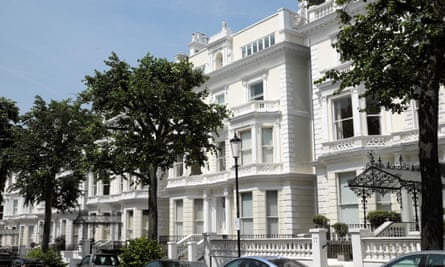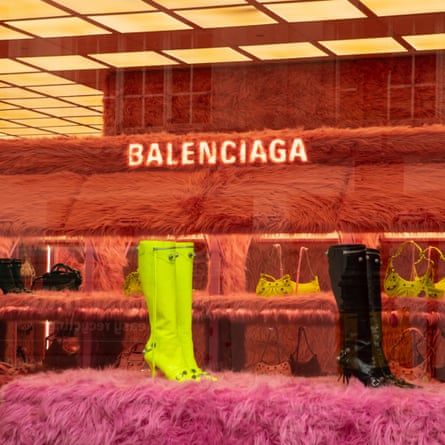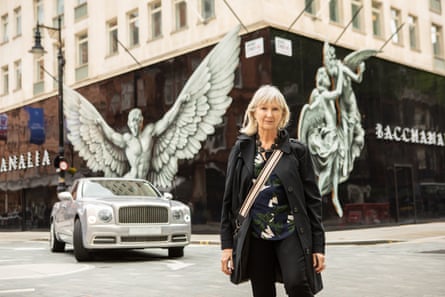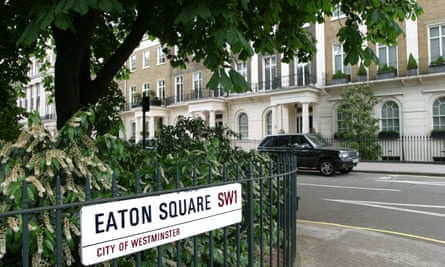“This,” announces Caroline Knowles, as we walk along a deserted road on the private Wentworth Estate in Virginia Water, “is where the trail runs cold. This is where money disappears from view.”
Knowles, a professor of sociology at Goldsmiths University, is interested in money, in wealth, how it is spent and how, as she puts it, it got “encrusted in the landscape of London”. That’s essentially the subject of her new book, Serious Money. Its subtitle is Walking Plutocratic London, and that’s exactly what she does in its pages, striding from Shoreditch and the City, through to St James’s, Mayfair, up to Regent’s Park, back down to Belgravia, Knightsbridge, Kensington, Notting Hill, Chelsea and out west to Richmond and finally Virginia Water.
What she means by the trail running cold is that in this gated community wealth retreats behind high walls and large view-blocking electric gates, taking up residence in the vast impenetrable mansions that are standard hereabouts. With its beautiful tall trees and conscientious armies of gardeners sweeping, pruning and blowing the spotless streets, the Wentworth Estate is as carefully manicured as the famous adjoining golf course.
 View image in fullscreenLuxury terraced homes in Holland Park, west London. Photograph: Kathy deWitt/Alamy
View image in fullscreenLuxury terraced homes in Holland Park, west London. Photograph: Kathy deWitt/Alamy
The eerie unpeopled roads put Knowles in mind of a fortified suburb in Johannesburg. To me they are a bit like Beverly Hills without the sidewalks or celebrities. Back in its hip period in the 1970s, residents of the estate included Elton John, a couple of Bee Gees and Diana Dors. But since Bruce Forsyth moved on to that great quiz show in the sky, the most notable figures, aside from several golfers, have been General Pinochet, the Chilean dictator who was held there under luxurious house arrest for 18 months at the turn of the century, and the former Tubeway Army frontman Gary Numan.
If the fame of the occupants is no longer electric, their wealth still packs a charge. Houses around here go for up to £50m. This is what’s known as “super prime” property – homes costing more than £10m. In 2020, despite coronavirus and the Brexit deadline, £1.3bn was spent on super prime property in the first eight months of the year, a rise of 16% on the previous year, although the number of sales was roughly the same.
“It’s largely new money,” says Knowles about Wentworth’s super primes, “or people who want to remain hidden.”
Taking her inspiration from the pyschogeographic meanderings of the writer Iain Sinclair and the intellectual perambulations of the German critical theorist Walter Benjamin, Knowles set out to explore the “plutocratification” of the capital on foot, observing the ways in which the super-rich have stamped their tastes, lifestyles and all-round expensive mark on a large swathe of the city.
 View image in fullscreenMoney is highly conspicuous in Mayfair’s shops, but the real action goes on in the less visible private equity firms around Berkeley Square. Photograph: Antonio Olmos/The Observer
View image in fullscreenMoney is highly conspicuous in Mayfair’s shops, but the real action goes on in the less visible private equity firms around Berkeley Square. Photograph: Antonio Olmos/The Observer
She walks everywhere, making observations as she goes, and meeting a number of rich or super-rich people along the way, all of whom are granted anonymity under the veil of nicknames such as “Banker”, “Blazer”, “Lady” and so on.
It’s not easy to access the seriously wealthy, and Knowles has to rely on the trust and goodwill of contacts of contacts, and sometimes contacts of contacts of contacts. She repays them with a faithful rendition of their views, sometimes tinged with little comments sharp enough to make you wince. When one Notting Hill resident tells her she likes the “social mix” of the neighbourhood, Knowles asks what that means, and hears a roll-call of professions: judges, economists, filmmakers and so on, leading her to observe acidly that the role of the poor is “lending authenticity to what would otherwise be a sterile plutocratic bubble”.
Many rich people feel anxious about poverty in London… They don’t want to trip over beggars outside the opera houseCaroline Knowles
But I can see how her interviewees might have let their guard down. Knowles is a disarming figure, thoughtful, self-effacing, but alive to the many ways that money puts a distance between the haves and have-nots. She is also keenly aware of the tensions that exist between the rich and the super-rich, or as she calls them, the haves and have-yachts, the so-called ultra high-net-worths with more than £20m in assets – excluding their main residence.
A few days before we go to Virginia Water, I meet Knowles at the Wolseley restaurant in Piccadilly, a celebrated hangout of the rich and famous, which sits between the clubland of St James’s to the south and the playboy heritage of Mayfair to the north. She tucks into a sustaining breakfast while we prepare for our own pounding of the plutocratic streets.
It’s abundantly evident that, with the Ritz hotel next door and the Royal Academy just across the road, we’re in an elite part of town. But wasn’t it ever thus? It’s not like London was ever some unvarying egalitarian utopia or dystopia, depending on your view of these things.
 View image in fullscreenCaroline Knowles in Mayfair’s Berkeley Square. Photograph: Antonio Olmos/The Observer
View image in fullscreenCaroline Knowles in Mayfair’s Berkeley Square. Photograph: Antonio Olmos/The Observer
“Yes,” she agrees, “London has always been a machine for extracting money from capital and piling it up. All cities are about that to some extent. But it’s also a modern phenomenon, because the wealthy bits of London have progressively expanded into different areas. Richmond was always a bourgeois kind of landscape, but now it’s been taken over by superwealth.” The average price of a detached house in Richmond is now almost £3.5m.
“There’s been something going on since the 90s which has drawn people from other countries to London,” says Knowles, who notes that 49% of property sales in central London in 2020 were to overseas buyers. According to Forbes magazine, London now has the fourth most billionaires of any city in the world. It has consequently developed what Knowles calls “a whole ecosystem” for dealing with wealth: hedge funds, private equity firms, and what are known as family offices – a one-stop shop, as it were, for wealth management, with everything from daily expenses to investments being overseen by a dedicated team. Much of this ecosystem is based just north of the Wolseley, in and around Mayfair, which boasts the highest density of private equity firms in the world.
Some of the people who have found London an alluring location are, of course, the Russian oligarchs who’ve recently been subject to sanctions following the invasion of Ukraine. According to Transparency International, Russian businesspeople and officials accused of corruption or links to the Kremlin own at least 150 properties in the UK worth £1.5bn – mostly in London. However, Knowles is quick to note that most rich Russians in London are not oligarchs. She speaks to several in her book who say that they earned their money in finance or IT.
“I found Russians actually very ready to speak,” she says. “The Russian billionaires I talked to were very open about their wealth, although they’ve often reinvented themselves as philanthropists and patrons of the arts.” Many, she says, are in London to get as far away from Putin as they can.
Capacious rooms have ceilings so high a giraffe could walk through them without having to bend its neck
Outside we head up to Mayfair, which alongside the hedge funds and private equity firms, is said to contain 28% of London’s Michelin-starred restaurants. It’s an odd place, because in one sense the money is highly conspicuous – there are the famous hotels, Claridges, the Connaught, the Dorchester, with their chauffeur-driven clientele – the art galleries and the luxury-car showrooms that never seem to have any customers.
But the real action goes on in the offices around Berkeley Square, hidden away behind the facades of Georgian town houses. Not bound by large banks, private equity firms, writes Knowles, are “driven by the relentless expansion of money, whatever the consequences”. It could be asset-stripping or investment in unsavoury regimes; the key thing is rate of return on investment. Two years ago the value of UK listed companies bought by private equity was £4bn. Last year it was £29.3bn.
Outside the Saudi Arabian Embassy in Charles Street, she wryly observes the site of a protest against the imprisonment and sentence of 800 lashes handed out to the Palestinian poet Ashraf Fayadh in 2016. “Just as in London you are supposedly never more than 6ft away from a rat,” she writes in the book, “in Mayfair you are rarely far from a serious human rights violation.”
We move on down through St James’s to the Nash-designed splendour of Carlton House Terrace. At one end is the British Academy, of which Knowles is a member. We pay a quick visit around its capacious rooms with ceilings so high a giraffe could walk through them without having to bend its neck. The staircase alone is a wonder to behold, the kind of sight that transports you back to an Upstairs Downstairs era of balls and servants. A few doors along are three houses belonging to the the Hinduja brothers, the multibillionaire industrialists. It was as a result of making a phone call to the Home Office in 2001, on behalf of Srichand Hinduja, who was seeking British citizenship, that Peter Mandelson was forced to resign from the Labour government for the second time.
 View image in fullscreenVirginia Water, Surrey: a prime location for multimillion-pound homes. Photograph: Greg Balfour Evans/Alamy
View image in fullscreenVirginia Water, Surrey: a prime location for multimillion-pound homes. Photograph: Greg Balfour Evans/Alamy
It’s since been made a little easier for the very wealthy to gain British citizenship, and the speed with which they become eligible for indefinite leave to remain is directly linked to investment. Invest £2m and it’s five years. Invest £5m and it’s three. Ten million gets you the right to stay for ever after two years.
It was Mandelson, of course, who famously said that he was “intensely relaxed about people getting filthy rich as long as they pay their taxes”. The filthy rich, however, are extremely adept at tax avoidance. One character Knowles meets, who made his fortune in private equity and lives in a six-storey Mayfair house with 7,000sq ft of space, argues that people like himself should pay more tax, and that tax breaks should only be given to those investments that “contribute to collective wealth creation”.
“I found a lot of rich people feel anxious about the levels of poverty in London,” she says, adding acerbically: “They don’t want to trip over beggars on leaving the opera house.”
We walk through Pall Mall’s clubland, with its austere buildings filled with hushed libraries and comfortable chairs to doze in, and on to Belgravia, the land of embassies, and once there to Eaton Square, which has been called Red Square, owing to the number of Russian billionaires who have homes here. They included Roman Abramovich, Oleg Deripaska and Andrey Goncharenko. The first two have been sanctioned, but Goncharenko, CEO of a Gazprom subsidiary, who also owns the £120m Hanover Lodge in Regent’s Park, has not had his property impounded. Leasehold apartments in Eaton Square range from £2-£10m.
The square forms the centrepiece of the Grosvenor Estate, a large area of prime real estate owned by the Duke of Westminster. They may be on long leases, but all the wealthy occupants of houses and apartments around here are tenants of the 31-year-old duke, who is estimated to be worth more than £10bn, and was at one time said to be the richest person in the world under 30. This is where new money meets the very old – the oligarchy and the landed gentry.
“Have you noticed how every house has magnolias in their window box?” asks Knowles.
She’s right, they do. It’s a feature of the Grosvenor Estate, apparently, some kind of floral requirement. It’s one of the decorative touches that help normalise a strange legacy of the distant past. It’s now politically acceptable to feel a sense of outrage at Russians or billionaires from other nations, who took advantage of a corrupt state to gain their wealth. But of aristocrats whose forebears did something similar with land, only hundreds of years ago, we’re still in social awe.
The duke turned down Knowles’s request to be interviewed. Instead she got his estate manager. Again and again while writing the book, she discovered that you can’t penetrate the world of the rich. You have to be invited in, and it’s invariably on their terms.
There are areas of the capital that those from lower down the social ladder can only enter as servants or labourers
In any case, she’s less interested in very wealthy people as individuals than as representatives of the “mechanisms of plutocratic consolidation”, which is the material armoury that accompanies wealth – second (or third) properties, multiple luxury cars, domestic staff, private schools, private club membership, upwards to yachts and even private jet and private protection teams.
We walk on through Knightsbridge, along Hyde Park, via Kensington Palace Gardens – said to be the most expensive street in London – to Kensington, scene of the so-called “basement wars” that Knowles documents in her book. These are the conflicts that occur when the super wealthy move into an area and start digging downwards, sometimes two or three floors or even, in some cases, deeper.
It’s a sign of money, and the need for ever more space in an already cramped city, but it’s also frequently seen as an anti-communal development, an act that is an assault on the peace and quiet of neighbours. One celebrated case involved the singer Robbie Williams, who wanted to build a swimming pool in his basement, and his next-door neighbour, the Led Zeppelin guitarist Jimmy Page, who sought to stop excavation work for fear that it would damage his Grade I listed Tower House.
That got very bitter, but at least it was confined to the rock music fraternity and people of a similar wealth. More often the complaints are made by the “haves” and aimed at the “have-yachts”. The result has been a strengthening of community environmental groups, born of nimbyism, perhaps, but devoted to maintaining the “character” of an area by slowing the depredations of the super-rich.
 View image in fullscreenEaton Square – also known as ‘Red Square’, owing to the number of Russian billionaires who bought property there. Photograph: Martin Norris Travel Photography/Alamy
View image in fullscreenEaton Square – also known as ‘Red Square’, owing to the number of Russian billionaires who bought property there. Photograph: Martin Norris Travel Photography/Alamy
One weird aspect of all this is that the digging machines that are used to scoop out the basement spaces, Knowles writes, are often left buried amid the foundations. “Hiring a crane and blocking off the street to recover a £5,000 or £6,000 digger is not cost-effective in a multimillion-pound renovation.”
It makes you wonder what archaeologists of the post-apocalyptic future will make of these mysterious artefacts when they are eventually reclaimed from their resting place. If all other signs of Kensington’s glory were to disintegrate into radioactive dust, will they be able to work out the finely stratified nature of the civilisation that produced these subterranean machines?
From the stuccoed streets north of Kensington High Street we walk north to Holland Park, home – among other locations – to David Beckham and Sir Richard Branson, then on to Notting Hill. In her book, Knowles interviews several Notting Hill wives involved in a charity to support Grenfell Tower survivors.
It’s a painful disjunction between the beautiful avenues with their elegant houses and communal gardens and the burnt tower block in which 72 people lost their lives. And it makes for some of Knowles’s most uneasy conversations.
“I think they were a group of women who looked for meaningful ways of spending their time,” she says. “I think what they were searching for was some kind of authenticity.”
The reader is left in doubt as to whether they ever truly find it, but then that’s in the nature of their predicament. To cross the class and economic divides that mark, or scar, London is not a journey many are able to make successfully. At least in Notting Hill there is still a sense of the cheek-by-jowl poles of wealth and poverty that have long distinguished London from other European cities, in which the poor are often safely kept away from the rich.
But perhaps the overriding impression left by my walk with Knowles and by her book is that the most advanced form of gentrification – plutocratification – is creating whole areas of the capital that those from lower down the social ladder can now only enter as servants or labourers.
“A city,” she writes in conclusion, “without reciprocity, collective life and neighbourhood interaction, in which everything is bought and paid for, is a bleak prospect – and an unsustainable one.”
What’s the answer, I ask.
“We need to press ahead with redistributing some of the enormous wealth that sits in London, and which sits in Mediterranean harbours in yachts, not even being used by the rich themselves,” she says, and then concludes with her own question, of the kind that never quite receives a proper answer: “Why is all that dead money not being used to make things happen?”
Serious Money by Caroline Knowles is published by Allen Lane (£25). To support the Guardian and Observer order your copy at guardianbookshop.com. Delivery charges may apply


